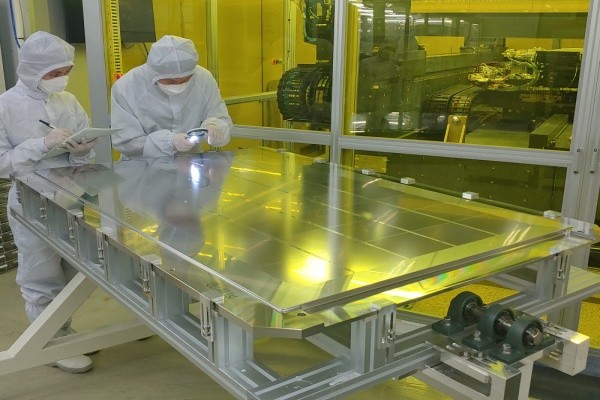A South Korean company has developed a new FMM (fine metal mask) technology that is suitable for manufacturing large OLED displays with high resolution. South Korea’s display industry is interested on whether the technology will be able to overcome current limitations in FMM process that are seen as the most difficult task in OLED display manufacturing process. FMM is a metallic plate that is thinner than a sheet of paper and is an important component that deposits organic materials to an accurate location during OLED display manufacturing process.
Olum Material announced on Thursday that it has developed a FMM technology in a form of single cell. The company’s technology, which is also called ‘unit cell FMM’, places a FMM in each panel.
Current OLED manufacturing process uses FMM sticks that are in a form of long band.
A FMM stick requires a very accurate control. Not only is a FMM a very thin metallic plate, but it can also easily be crumpled or damaged due to its long length. To maintain accurate degree of precision in location, technology that can tension and weld FMMs is required. Olum Material designed a cell concept to overcome these limitations. Just like how tiles are attached one by one, the company designed a concept where FMMs are attached to a frame and used for deposition process of OLED manufacturing process.

Although the unit cell FMM method makes individual panel through individual FMM rather than many panels at the same time, it is able to drastically reduce time in production and number of faulty products as it does not require tension. Lee Byung-il, who is the CTO of Olum Material, said that the company’s unit cell FMM method is able to increase productivity of OLEDs because the method welds FMMs to a frame in a short period of time and does not require tension.
CTO Lee also emphasized that the method is also excellent for realizing high resolution. Higher resolution requires many more fine deposition holes to be made and FMMs to be thinner. However, FMM sticks can only be 20 micrometers in thickness while the company’s method can materialize FMMs that are 10 micrometers in thickness. Also, because the method simply requires FMMs with a large area rather than attaching many FMM sticks, it is more advantageous in manufacturing medium to large-sized OLEDs for foldable devices, tablets, and laptops.
Olum Material has completed development of FMM technology that can deal with 2G, 4G, and 5.5G and it announced that it has also completed development of a prototype for 6G as well. Its prototype is for foldable devices that support QHD resolution and it is ready to be shipped to foreign customers for final verification. CEO Jang Tae-yong of Olum Material said that the company would look to overcome limitations in OLED manufacturing process by opening up a new horizon through its uc-FMM concept.
FMM stick is seen as an item that urgently needs to be localized as South Korean companies depend largely on Japanese companies for FMM sticks. The global market for FMM is estimated to be worth between $630 million (700 billion KRW) and $720 million (800 billion KRW).
Staff Reporter Yun, Geonil | benyun@etnews.com